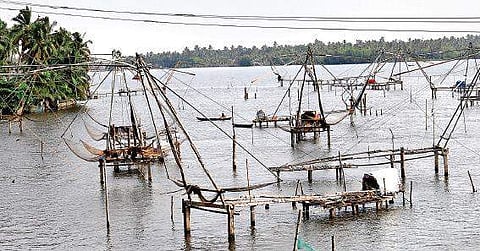Several of the iconic Chinese nets may go from Kochi
KOCHI: The silhouette of fishing nets against the reddish-orange hued sky could possibly be Kochi's perpetual wallpaper. Comprising an aggregation of coastal hamlets popularly known more or less for their famed fishing nets, Kochi stands distinct from the other port cities. Known in local parlance as the 'cheena vala', fishermen and owners of these nets have been tangled in issues themselves. Ranging from older damaged nets to newer unlicenced nets, the list is aplenty.
Recently, the Department of Fisheries has issued a notice to owners of the fishing nets in Kumbalangi, Edakochi and Kallanchery, demanding the removal of unlicenced nets. The last notice urging to dismantle unlicensed nets was served in 2003, and ever since, more than 700 unlicenced nets have cropped up in these backwaters. One can't help but wonder why it has taken so long to investigate and discover unlicensed nets.
"The Department of Fisheries is the sole authority to issue licences to those that do not fall under CPT. In such regions, when one installs a net sans licence, the others follow suit. The district authority must be convinced about the livelihood of the applicant. Also, there wasn't enough patrolling these years to scrutinise illegal fishing nets. The Inland Fisheries Act is taken more stringently now, which explains the latest notice," said Jayanarayanan, director, central zone (Ernakulam) of Department of Fisheries.
Nets with licence
Kumbalangi panchayat president Martin Antony said older nets are licenced, in fact it is the newer ones which continue to operate without one. "There are more than 1,000 nets in Kumbalangi itself. Among these, only 10-50 of them are licenced. The Department of Fisheries is supposed to issue the licence. But they have sent a notice demanding the removal of unlicensed nets citing obstruction in water as the reason," he said.
In comparison to a large number of nets, places like Fort Kochi and Vypin have a lesser number but are licenced. "Fort Kochi and Vypin fall under the jurisdiction of the Cochin Port Trust which issues and renews licences for the fishing nets on a yearly basis. However, the number of these licenced nets are rather less," said Shiny Mathew, Fort Kochi councillor.
Nevertheless, regardless of jurisdiction, why aren't fishing nets in Kumbalangi, Kallanchery and Edakochi issued a licence? "Nets installed closer to the coastal area are safe due to a harder water bed. Fort Kochi being an example. The net posts are laid 20 feet into the sea bed and will not plummet despite strong undercurrents. Whereas, in places such as Kumbalangi, the nets are installed in the middle of the backwaters. They are unable to withstand strong winds as the water bed comprises loose soil.
Also, it primarily upset navigation of other boats and disrupts marine life. This could be a major reason for the hesitancy in issuing a licence," said Derrson Antony, Chinese Fishing Nets Owners Association. He stressed on the fact that fishing nets in Fort Kochi are rather few. "There were 23 nets in total, however only six Chinese nets are operational now. These are all licenced, in fact, the owners of destroyed nets continue to pay money and renew their licence on the hope of getting it fixed someday," he said.
The removal of fishing nets in such places could play a role in tampering with the livelihood of the fishermen. "I doubt if that is a problem. The fisher community has two sources of income - one which requires them venturing into the deep seas for trawling and the other, operating fishing nets in the backwaters. Moreover, most nets in Kumbalangi are owned by individuals who have houses at a particular coast, and not poor fishermen," Derrson continued.
Unsafe waterbed
Nets installed closer to the coastal area are safe due to a harder water bed. Fort Kochi being an example. In Kumbalangi, the nets are installed in the middle of the backwaters. They are unable to stand strong winds as the water bed comprises loose soil.

